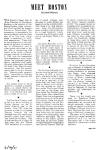
Home Page Meet Boston Menu Index
|
MEET BOSTON Friday, February 21, 1941 in What's New In Town W. J. Sidis |
Opposite Mechanics Building used to be, some sixty years ago, Boston’s baseball park. The other end of the field―about where the Irvington Street Armory now is―was a bicycle race-track.
*
Thirty or forty years ago the expression “Cross Town” was in common use for the section of Massachusetts Avenue between Tremont and Huntington―now more commonly called “Uptown,” and the region now served by Symphony Station.
*
When there was still water in the Back Bay, ninety years ago, the Mechanics Association conceived the unusual project of setting up a large building in the middle of the bay, on a pier, for headquarters, for entertainment, and for exhibitions. This was one of the largest pierhead buildings of its sort ever erected but it drew large crowds, who went out on the long pier to see what was popularly called “the house in the water.” When the Back Bay was filled in, the pier became West Newton Street, and the crosswalk in front of the pier building became part of a wide street designated on city plans of the time as “Avenue Number VI,” but later named Huntington Avenue. And through all the change in its surroundings, the old Mechanics Building stood steadfast, still serving the purpose of office and exhibition hall as in the days when it was the world’s original amusement pier. With the opening of a new subway station at the spot, the site bids fair to become a new center for the city’s growth, bringing the old building back into importance in perhaps a new role.
*
The largest of Boston’s numerous 19th century railroad terminals (there were about ten of them) was the “Providence Depot” at Park Square. Being the main terminal for trains to New York, it had much the same importance as its modern successor, the South Station, which replaced it in 1900. A hundred years ago, when the Back Bay was a bay, the Boston and Providence Railroad was built, entering Boston by a long trestle over the bay, crossing the B. & A.’s similar trestle in the middle of the bay (near the present location of Dartmouth Street). The railroad then had its terminal on a pier set out into the bay next to the Common . . . and the immense Providence Depot arose from the pier, and Park Square grew around its approach. After the Civil War, the Back Bay was filled in, and the Depot was no longer a pier, but a splendid building overlooking the new section of the city from a steepled tower that dominated the city’s skyline. In the great fire of November, 1872, that consumed most of Boston in three terrible days, the Providence Depot was threatened by fire, but was saved; however, it was temporarily abandoned, while passengers were discharged at an emergency platform at the “crossover” of the Providence and the B. & A. railroads―the beginnings of the Back Bay Station. The world’s first subway, started in 1893 and opened in 1897, was in reality an express service from downtown Boston to the Providence Depot. But soon the Providence Depot was to be abandoned, and after the opening of South Station the old Depot became a skating rink for a while, then later the building was dynamited, and only the name of Providence Street, which ran on one side of the Depot, preserves its memory. The place remained a big hole in the ground till after the World War, when building began in that region. The Statler Building occupies the site of the old Depot (the offices are over the location of the waiting rooms, and the Hotel where the track platforms were), while in the former station yards, are the buildings of Paine Furniture, Liberty Mutual, and John Hancock. (The Paine Furniture was really the far end of the train sheds.) Some romantic interest attaches to the old Providence Depot because Providence was a favorite of Gretna Green of the Gay Nineties, and many a couple met at its gates to start on a trip that took in a visit to some justice of the peace in Little Rhody. We might almost wonder how many who married in haste in 1891 from that old depot, are repenting at leisure at their golden wedding in 1941. Or how many people living at present would qualify as “Providence Depot Babies,” and whether it should not constitute some bond of fraternity between them. The Provi-
(Continued on page 14)
[Continuation missing]